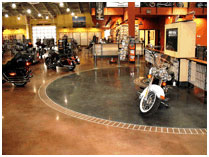When it comes to concrete floors, there are a number of ways to customize them. One of the easiest and most common ways of doing this is to add color with acid stains or solvent based stains.
Acid stains for concrete floors and countertops are generally a mix of water, hydrochloric acid, and metallic salts. The acid breaks down the surface of the concrete and causing a chemical reaction with the hydrated lime that exists within the concrete. What’s nice about using an acid stain is that because the acid breaks down the surface of the concrete and the colorant is actually a chemical reaction, the color will remain as vivid and bright as the day it is applied and will not fade, chip away or scratch.
The main drawback of using acid stains is that you have little control over the color that develops. Because the process involves a chemical reaction, the color that you get will be based on the level of reaction that occurs. There will be natural color variations throughout the concrete. In addition, the color selection is somewhat narrower than with solvent based dyes. For the most part, you can get earthen tones and blues/greens.
Water- and Solvent-Based Dyes
Solvent based dyes involves the application of colorant to the concrete itself. It does not require a chemical reaction to occur. This means that you have more color choices and can expect a more uniform coloring process. However, using a dye exclusively will not produce the same long term results as using a dye.
In most cases, homeowners use solvent based dyes to enhance acid stained concrete in order to add color intensity to areas where the chemical reaction wasn’t a dynamic or to add additional color choices. In addition, custom colors can be made by mixing, diluting or concentrating various dyes.






Comments are closed.